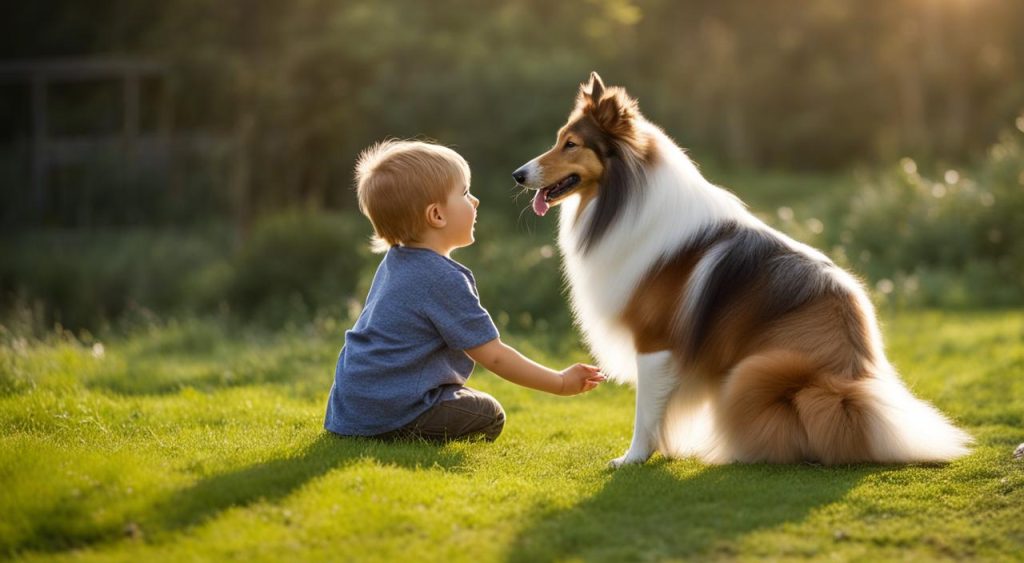Shetland Sheepdogs, known for their social nature and strong bond with their owners, are prone to experiencing separation anxiety. When left alone for extended periods of time, these dogs can become anxious and distressed, exhibiting behaviors such as whining, pacing, excessive barking, destructive chewing, and indoor elimination. Separation anxiety in Shetland Sheepdogs can be influenced by various factors, including genetics, trauma, early weaning, and neglect. It is crucial to address this issue in order to foster a happier and calmer environment for both the dog and the owner.
Key Takeaways:
- Shetland Sheepdogs are predisposed to separation anxiety due to their social nature and strong bond with their owners.
- Common symptoms of separation anxiety in Shetland Sheepdogs include whining, pacing, excessive barking, destructive chewing, and indoor elimination.
- Factors contributing to separation anxiety include genetics, trauma, early weaning, and neglect.
- Managing separation anxiety involves providing regular exercise and mental stimulation, gradual desensitization to departures, creating a safe and comfortable space, and seeking professional guidance.
- Consulting with a professional dog trainer or veterinarian can help develop a personalized plan to address separation anxiety in Shetland Sheepdogs.
Causes of separation anxiety in Shetland Sheepdogs
Separation anxiety in Shetland Sheepdogs can be attributed to various causes. Understanding these causes can help dog owners identify and address the underlying factors contributing to their pet’s anxiety.
Genetics and Breed Predisposition
Genetics play a significant role in the development of separation anxiety in Shetland Sheepdogs. Certain breeds, including Shetland Sheepdogs, have a higher predisposition to anxiety and insecurity, making them more susceptible to separation anxiety.
Previous Traumatic Experiences
Dogs that have experienced traumatic events, such as abandonment or being rescued from puppy mills or shelters, are more likely to develop separation anxiety. These experiences can leave a lasting impact on a dog’s emotional well-being, causing heightened anxiety when left alone.
Early Weaning Practices
Early weaning, where puppies are separated from their mother and littermates prematurely, can contribute to separation anxiety in Shetland Sheepdogs. Lack of proper socialization and early bonding experiences can make the transition to being alone more challenging for these dogs.
Neglect and Lack of Social Interaction
Another significant factor in the development of separation anxiety in Shetland Sheepdogs is neglect and a lack of social interaction. Dogs that are not adequately engaged, mentally stimulated, and given sufficient attention are more prone to anxiety when left alone.
By addressing these causes, dog owners can take proactive steps to prevent and manage separation anxiety in their Shetland Sheepdogs, promoting a healthier and happier bond between them and their pets.
Managing separation anxiety in Shetland Sheepdogs
Dealing with separation anxiety in Shetland Sheepdogs requires a multi-faceted approach to help alleviate their distress. By following these tips and techniques, you can create a calmer environment for your furry friend:
1. Provide regular exercise and mental stimulation: Engaging your Shetland Sheepdog in physical activities and interactive toys helps release excess energy and reduces anxiety. Daily walks, playtime, and puzzle toys can keep them entertained and mentally stimulated.
2. Gradually desensitize departures: Help your Shetland Sheepdog become more comfortable with being alone by gradually increasing the duration of your departures. Start with short periods and gradually increase the time apart, reassuring them with positive reinforcement when you return.
3. Create a safe and comfortable space: Designate a specific area within your home where your Shetland Sheepdog feels secure. Provide familiar bedding, toys, and a cozy atmosphere to offer a sense of comfort when they’re alone.
4. Consult a professional and consider medication: If the anxiety persists, consulting with a professional dog trainer or veterinarian experienced in separation anxiety can be beneficial. In severe cases, medication prescribed by a veterinarian may be necessary to manage your Shetland Sheepdog’s anxiety levels.
5. Consider natural supplements: Some pet owners have found success in using natural supplements, such as CBD oil, to help calm a Shetland Sheepdog’s nervous system. However, it’s essential to consult with a veterinarian first, as they can provide guidance on the appropriate dosage and usage.
Remember, each Shetland Sheepdog is unique, and addressing separation anxiety may require a tailored approach. By implementing a combination of exercise, gradual desensitization, creating a safe space, seeking professional advice, and considering natural supplements, you can help your Shetland Sheepdog overcome separation anxiety and improve their overall well-being.





